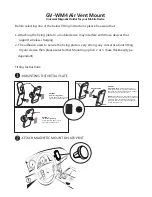
Asynchronous Transfer Mode (ATM) Module Installation and User Guide
1-9
About the ATM Module
Service Provider Features
The ATM module provides the following features for service provider environments:
•
DSCP mapping
•
VLAN ID (VID) tag mapping
•
VLAN ID (VID) tag nesting
•
VLAN to PVC mapping
DSCP Mapping.
You can use the
diffserv dscp-mapping
command to configure a
mapped relationship between an input DSCP and an associated output DSCP. Each
ATM port supports three DSCP mapping tables: one of the tables is used in the ingress
direction; two are used for egress flows (onto the ATM link). The two egress tables are
for the congested and noncongested states, as determined by the RED algorithm. If RED
is not enabled on the ATM port, the egress congested-state mapping table is not used.
In the ingress direction, the input DSCP of a packet received from the ATM link is
replaced by an output DSCP before the packet is forwarded. In the egress direction, the
operation is similar, except that the DSCP mapping occurs before the packet is
transmitted onto the ATM link.
One potential use of the DSCP mapping capability is to reconcile varying DiffServ
policies at the boundary between autonomous systems, such as at the boundary
between two ISPs. The availability of different tables for the congested and
noncongested states is useful in marking operations that increase the probability of
packets being dropped during times of congestion, as discussed in the DiffServ Assured
Forwarding RFC (RFC 2597).
VLAN ID (VID) Tag Mapping.
An analogous feature has been added for the managing
of 802.1Q tags. The
dot1q tagmapping
command provides support for VLAN ID (VID)
mapping tables. Each ATM port supports two VID tables: one table is used in the
ingress direction; the other is used in the egress direction. Each of the tables enables an
input VID to be mapped to an output VID. This feature is useful in reconciling policy
differences at the boundary between the customer and the service provider.
VLAN ID (VID) Tag Nesting.
Another related enhancement provides support for
nested 802.1Q tags by allowing a tag push or tag pop attribute to be associated with a
VID. The push attribute indicates that a new tag is to be added to the frame, while the
pop attribute indicates that the top-level tag is to be removed from the frame. This
capability is augmented by an option that allows the 802.1p priority of the frame to be
either preserved or set to a user-configurable value when a new tag is pushed. These
Содержание BlackDiamond 6800
Страница 8: ...viii Asynchronous Transfer Mode ATM Module Installation and User Guide ...
Страница 10: ...x Asynchronous Transfer Mode ATM Module Installation and User Guide ...
Страница 14: ...xiv Asynchronous Transfer Mode ATM Module Installation and User Guide ...
Страница 100: ...A 8 Asynchronous Transfer Mode ATM Module Installation and User Guide ...
Страница 104: ...B 4 Asynchronous Transfer Mode ATM Module Installation and User Guide ...
















































